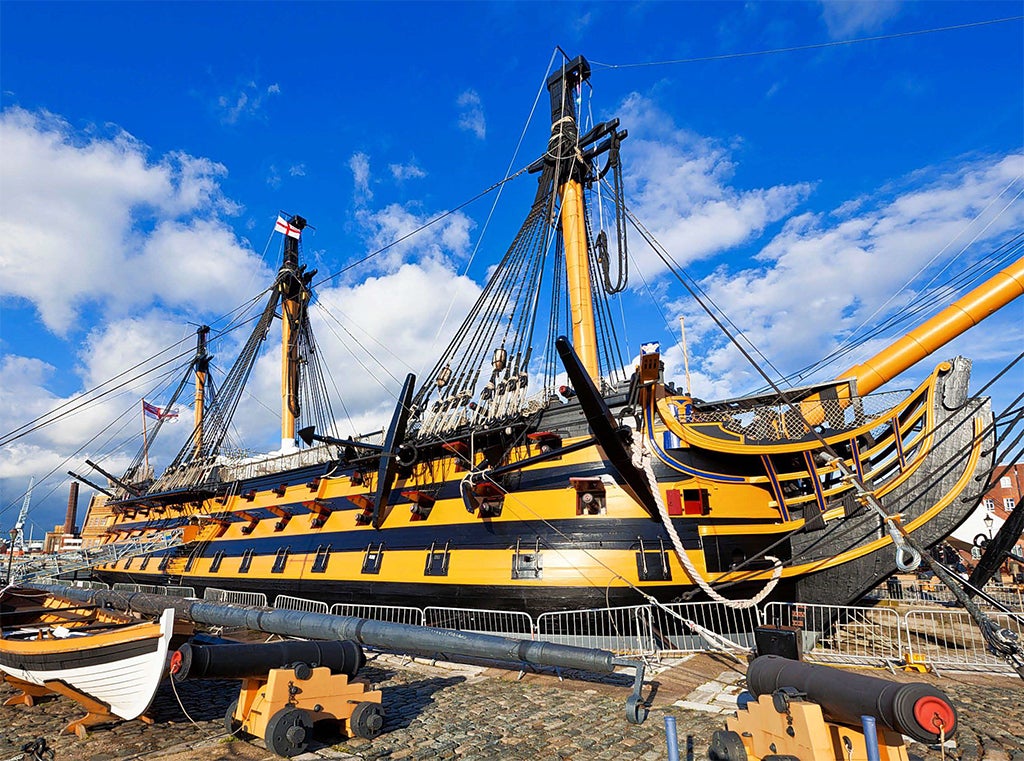The Independent's journalism is supported by our readers. When you purchase through links on our site, we may earn commission.
See Portsmouth through history
Inspire your family with a journey to England’s past

AD 501
Portsmouth is (allegedly) first founded by Port the pirate and his two sons, Bieda and Mægla, after they arrive by ship and slay a local nobleman.
DO IT: Head to Clarence Pier, where Pirate Pete’s play area will entertain young wannabe Jack Sparrows.
http://www.clarencepier.co.uk/play-area.html
1181
Portsmouth's first real church – a chapel dedicated to Thomas Becket – is built by Augustinian monks.
DO IT: Visit the Portsmouth Anglican Cathedral, which stands on the site of the original chapel, and has been attacked, rebuilt, extended and renovated over the subsequent centuries.
http://www.portsmouthcathedral.org.uk/
1194
Portsmouth receives its first royal charter from Richard I (Richard the Lionheart).
DO IT: More than 800 years on, take to Portsmouth's Millennium Trail, which opens up previously off-limits areas of waterfront and brings together the maritime history of the city.
http://www.visitportsmouth.co.uk/things-to-do/millennium-trail-p276841
1545
The Mary Rose sinks – with Henry VIII watching on from the ramparts of Southsea Castle.
DO IT: See the flagship carrack-style vessel on display at the new Mary Rose Museum and stand where Henry did at Southsea.
http://www.historicdockyard.co.uk/maryrose/
1664
The 'Duke of York and Albany's maritime regiment of Foot' is formed – the origins of the Royal Marines, the amphibious division of the infantry. It is formed in London, but has strong links to Portsmouth.
DO IT: Try out commando training at the Royal Marines Museum, located in the Officers' Mess of the former barracks in Southsea. The museum looks back at the history of the division, and what it’s like to be a marine in the 21st century.
http://www.royalmarinesmuseum.co.uk/
1805
Nelson sails off from Portsmouth to fight the Battle of Trafalgar. He is shot, and dies on 21 October aboard his flagship, HMS Victory – now docked in the city.
DO IT: Follow the Nelson Trail round the city. Interpretation panels line the route from Landport Gate to the Victory Anchor on Clarence Esplanade, linking sites associated with the Lord Admiral. Then visit his flagship, HMS Victory, to see where he died.
http://www.visitportsmouth.co.uk/things-to-do/nelson-trail-p282141
http://www.historicdockyard.co.uk/hmsvictory/
1812
Charles Dickens is born on 7 February at 1 Mile End Terrace
DO IT: Visit the Charles Dickens Birthplace Museum, located in the very Regency house in which he was born. See Dickens memorabilia and, on the first Sunday of each month (April-September), hear readings from his works.
http://www.charlesdickensbirthplace.co.uk/
1860
HMS Warrior launched – powered by steam and sail, she becomes, for a short time, the largest, fastest and most powerful ship on the seas.
DO IT: Climb aboard HMS Warrior – berthed at Portsmouth's Historic Dockyard – to experience life as a Victorian sailor: sit at the mess table, join a gun drill and watch her great engine whirr.
1886
Sir Arthur Conan Doyle creates his famous detective Sherlock Holmes while working and writing in Portsmouth
DO IT: Visit the Study in Sherlock exhibition at Portsmouth Museum where you can also discover more about all aspects of the city’s history.
http://portsmouthcitymuseums.co.uk
1926
Portsmouth is granted city status.
DO IT: Get an overview of the whole urban area and beyond – with views stretching up to 37km in every direction – from the 110m-high view deck of the Spinnaker Tower.
http://www.spinnakertower.co.uk/
1944
Boats disembark from Portsmouth and Southsea on 6 June – D-Day – bound for the beaches of Normandy.
DO IT: Explore The D-Day Story, which brings to life perhaps the most pivotal event of World War Two. Don't miss the 83m-long Overlord Embroidery – inspired by the Bayeux Tapestry, it traces the progress of Operation Overlord (the invasion’s codename), from its origins in 1940 to victory in 1944.
For more information on planning your visit to Portsmouth, explore http://www.visitportsmouth.co.uk
This article was amended on 21 September 2022 to update the information about The D-Day Story.
Join our commenting forum
Join thought-provoking conversations, follow other Independent readers and see their replies
Comments